|
HAWAII NATURE NOTES
THE PUBLICATION OF THE
NATURALIST DIVISION, HAWAII NATIONAL PARK
AND THE HAWAII NATURAL HISTORY ASSOCIATION
|
UKI
Cladium angustifolium—Sedge Family (Cyperaceae)
|
|
A common plant in wet and moderately wet areas is the
uki, which grows to heights of 3 to 4 feet. The uki has a
flattened stem and long, slender rushlike leaves. Flowers and seeds
develop in heads which form at the top of the stalks. Often the plant is
seen after the seeds have been dropped, and the cases in which they
developed have taken on a dark, rust-brown color.
Although grasslike in its general appearance, the
uki is actually a sedge. As is often the case with plants of this
family, the stem of this plant is triangular in cross section. Another
common sedge in the park, though not native, is the kilioopu, or
nutgrass (p. 24).
|
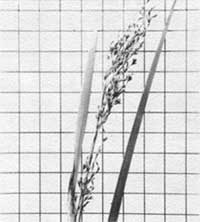
(Inch squares on background)
|
|
HONOHONO OR CREEPING DAYFLOWER
Commelina diffusa—Spiderwort Family (Commelinaceae)
|
|
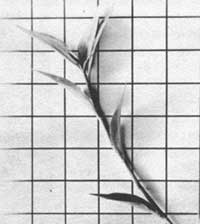
(Inch squares on background)
|
In moist localities, along trails and roadsides, you
may see a low, creeping plant with slender, spear-shaped leaves. The
plant bears small, bright blue flowers where the leaves join the stem.
It is a close relative of the "Wandering Jew," a common house plant on
the mainland. Although it may be an exotic, this has not been
established and some botanists are of the opinion that it is native
because of its wide distribution, even in remote, inaccessible
localities.
Valuable as moisture-preserving ground cover, the
dayflower may become a pest in areas where it chokes out other plants.
It is common in the vicinity of the Thurston Lava Tube parking area.
|
|
PAINIU
Astelia menziesiana—Lily Family (Liliaceae)
|
|
The painiu is sometimes mistaken for the
silversword, the latter being found in abundance only in the Haleakala
section of the park. Painiu is an attractive plant whose leaves
and stalks have a soft, fuzzy, silvery appearance. The flowers are
greenish in color. When in fruit large clusters of bright orange berries
are borne on a stalk at the center of the plant. Although usually found
growing on the ground, the painiu adapts itself readily to life
as an epiphyte—a plant which grows upon another plant but
which does not injure or take food from the "host." They may often be
seen growing upon trees. The outer covering of the leaves was sometimes
used by the Hawaiians in lei making.
The silver color of the painiu may be an
adaptation to reflect the rays of the sun, as it probably is with the
silversword and the silver geranium.
This member of the lily family is found in both the
Kilauea and Haleakala sections of the park. In the Kilauea section dense
growths may be seen on Byron Ledge and in the vicinity of the old CCC
Camp, where it presents a colorful sight when the bright orange berries
are ripe. You can also see it growing as an "airplant" on trees in Kalua
Iki, the crater which produced the Thurston Lava Tube.
|
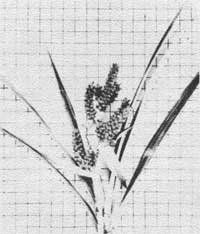
(Inch squares on background)
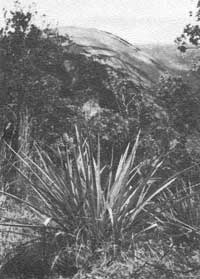
Painiu on rim of Kilauea Iki.
|
|
TI
Cordyline terminalis—Lily Family (Liliaceae)
|
|
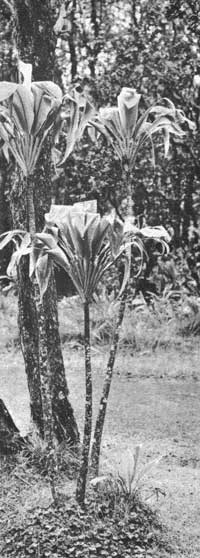
|
Few Hawaiian plants are more graceful than the
slender ti, pictured on the right. You can see it in many places
in the park residential area and occasionally in Kipuka Puaulu and in
old lava tube cave-ins in other portions of the park. With the exception
of the coconut palm it is doubtful if any plant was of greater use to
the Hawaiians. The leaves were used for skirts, for wrapping food, and
for thatching buildings. A potent beverage called okolehao was
distilled from the root of the ti during and following the
whaling days in Hawaii. These plants may grow to 12 or more feet high.
The leaves grow in a head at the top of the plant in a close spiral.
There are no branches. As leaves fall they are replaced by new ones in
the center of the head. Most authorities believe that the ti was
brought to Hawaii by the early Polynesian explorers.
The ti according to Degener, was regarded as
sacred to Lono, the god for whom Captain Cook was mistaken by the
Hawaiians. A symbol of high rank or divine power in old Hawaii,
ti was often worn around the neck of the kahuna, or
priest. It was considered a charm against evil spirits. The Hawaiians
used ti leaves for relief from headaches. A portion of the leaf
was soaked in cold water and tied around the head.
Holua slides provided sport in early days.
Similar to tobogganing, steep slopes were often covered with ti
leaves to make the sleds move more rapidly. Ti leaf sliding
continues as an exciting sport in Hawaii today.
|
|

